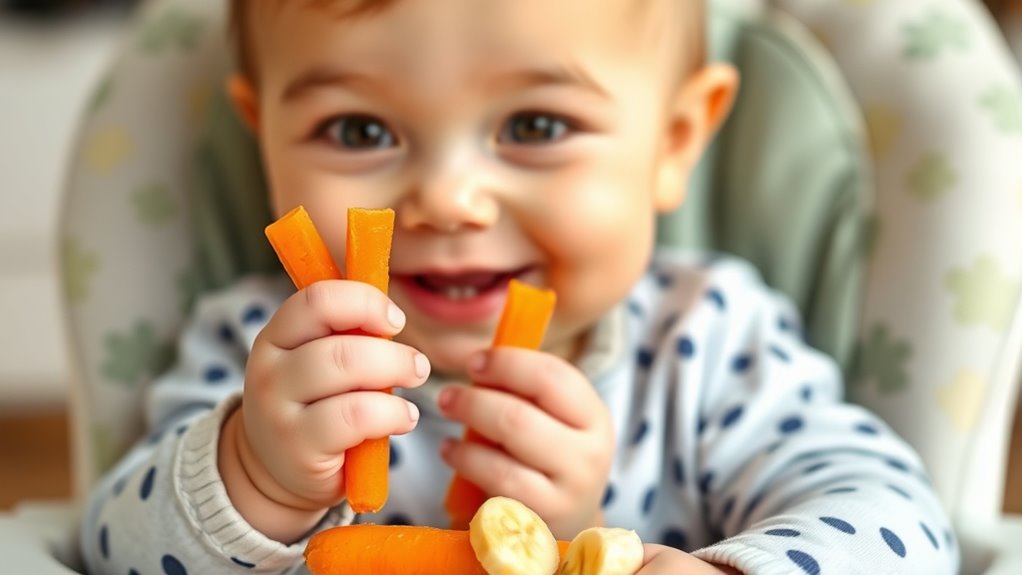Starting baby-led weaning around six months old allows your little one to develop eating skills and self-regulation. Look for signs like sitting unsupported, showing curiosity about food, and good head control. Offer soft, manageable foods like steamed vegetables, ripe fruits, and small grains, avoiding choking hazards. Always supervise mealtime and cut foods into safe sizes. Keep exploring these tips to make certain a safe and enjoyable introduction to solids for your baby.
Key Takeaways
- Begin baby-led weaning around 6 months when the baby can sit independently and shows curiosity about food.
- Offer soft, manageable foods like steamed vegetables, mashed fruits, and cooked grains to ensure safety and ease of eating.
- Always supervise mealtimes, cut foods into appropriate sizes, and avoid choking hazards such as nuts and sticky foods.
- Look for developmental signs like good head control, interest in food, and developing fine motor skills before starting.
- Create a calm, distraction-free environment and follow routine meal times to promote safe, positive self-feeding experiences.
Determining the Right Time to Start Baby-Led Weaning

Knowing when to start baby-led weaning is essential for your baby’s safety and development. Look for key feeding milestones that indicate your little one is ready, typically around 6 months old. Developmental readiness involves more than age; your baby should be able to sit upright without support, show curiosity about food, and have good head and neck control. These signs suggest they’re prepared to explore self-feeding safely. These milestones are linked to the development of self-control and coordination, which are crucial for safe eating habits. As your baby gains these skills, they also develop fine motor skills, which support successful self-feeding. Improving your understanding of motor development stages can help you better assess your baby’s readiness. Rushing the process can lead to choking hazards or frustration. Trust your instincts and observe your baby’s progress. Remember, each child develops at their own pace. Waiting until your baby reaches these milestones ensures they’re physically and developmentally prepared to handle baby-led weaning successfully.
Selecting Safe and Nutritious First Foods

Choosing the right first foods is essential to guarantee your baby’s safety and nutritional needs are met. Focus on offering soft, easy-to-mash options that encourage self-feeding. Incorporate mealtime routines to create consistency and comfort, making it easier for your baby to explore new foods. Use gentle spoon feeding techniques to introduce new textures and flavors gradually. Select foods that are rich in iron, vitamin C, and healthy fats to support growth and development. Avoid honey, whole nuts, and choking hazards. Here’s a helpful guide:
| Food Type | Examples | Preparation Tips |
|---|---|---|
| Vegetables | Steamed carrots, zucchini | Cut into strips or small pieces for easy grasping |
| Fruits | Ripe bananas, cooked apples | Mash or cut into manageable sizes |
| Proteins | Soft cooked chicken, fish | Flake into small, manageable pieces |
| Grains | Cooked rice, oats | Serve in small, manageable portions |
Essential Safety Tips for Successful Baby-Led Weaning

Starting baby-led weaning safely requires careful attention to your little one’s environment and eating habits. Watch for feeding cues that indicate your baby is ready to try new foods and stop when they signal they’re full. Always supervise your baby during meals to prevent choking hazards, and guarantee foods are cut into manageable, age-appropriate sizes. Keep small, hard, or sticky foods out of reach, as these increase choking risk. Create a calm, distraction-free setting to help your baby focus on eating and develop proper chewing skills. Pay close attention to their reactions and cues, and don’t rush the process. Prioritizing safety, patience, and responsiveness helps your baby enjoy mealtime while minimizing risks. Being aware of choking hazards and how to avoid them is essential for a safe weaning experience. Incorporating proper food preparation techniques can further reduce risks and promote safe eating habits. Regularly reviewing food safety guidelines ensures ongoing protection and confidence during the weaning process.
Frequently Asked Questions
How Do I Know My Baby Is Ready for Baby-Led Weaning?
You’ll know your baby is ready for baby-led weaning when they’ve reached feeding milestones like sitting unassisted and showing interest in your food. Look for developmental cues such as reaching for food, opening their mouth for bites, and showing curiosity during mealtimes. If they can coordinate their hands and mouth and demonstrate these signs, it’s a good indication that they’re prepared to start exploring solids through baby-led weaning.
What Signs Indicate a Baby Is Developing Eating Readiness?
Watch for signs that show your baby’s ready to eat independently. When they start moving food to their mouth with improved hand-eye coordination, it’s a positive pointer. If they stop the tongue thrust reflex, it’s a signal they’re prepared for new foods. Also, notice if they’re interested in what you’re eating and can sit upright steadily—these are key cues that your little one is developing eating readiness.
Are There Specific Foods to Avoid During Initial Weaning?
You should avoid foods that pose choking risks, like whole grapes, nuts, or hard candies, during initial weaning. Also, steer clear of foods that may trigger food allergies, such as honey, shellfish, or eggs, until your baby shows signs of tolerance. Introducing safe, soft, and easily manageable foods helps reduce choking hazards and supports allergy prevention. Always supervise your baby closely during mealtime to ensure safety.
How Can I Prevent Choking Hazards During Baby-Led Weaning?
Think of choking hazards as lurking shadows you can outsmart. To prevent choking during baby-led weaning, always supervise your baby, make sure foods are soft and cut into manageable pieces, and avoid foods that pose high choking risks. Watch for signs of food allergies and remove any unsafe items. By staying vigilant, you create a safe environment that encourages your little one to explore new foods confidently and safely.
What Should I Do if My Baby Refuses New Foods?
If your baby refuses new foods, don’t worry—fussy eating and food aversion are normal. You should keep offering a variety of foods without pressure, as repeated exposure often helps. Try different textures, flavors, and presentation styles to pique their interest. Be patient and gentle, and celebrate small successes. Over time, your baby may become more receptive, and your persistence will encourage healthy eating habits.
Conclusion
As you gently place that first soft, colorful piece of food into your baby’s tiny hands, remember you’re guiding them on a journey of discovery. With patience and care, you’re building a bridge from milk to independence, one safe bite at a time. Trust in your instincts, and watch as your little one explores the world through their newfound tastes, turning every meal into a beautiful, shared adventure of growth and trust.










